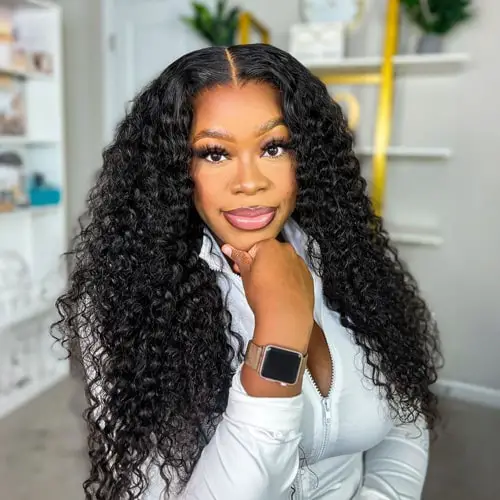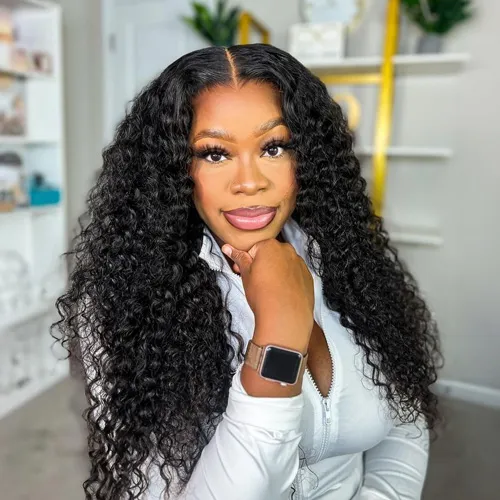How To Make A Wig Look Natural For Newbies?

Whether you’re looking to experiment with different hairstyles, conceal hair loss, or simply change up your look, wigs offer versatility and convenience. However, for newcomers to the world of wigs, achieving a natural look can seem daunting. Fear not, as with the right techniques and a bit of practice, anyone can master the art of making a wig look natural. In this guide, we’ll delve into the step-by-step process of achieving a seamless and realistic wig application.

About your wig:
Before diving into the application process, it’s crucial to understand the type of wig you’re working with. Wigs come in various materials, including synthetic fibers and natural human hair. Each type requires slightly different care and styling techniques to achieve a natural look.
Synthetic wigs:
Synthetic wigs are a popular choice due to their affordability and low maintenance. However, they require special care to prevent them from looking overly shiny or artificial. To make a synthetic wig look natural, follow these steps:
a. Invest in a high-quality synthetic wig:
Opt for wigs made from heat-resistant fibers, as they can be styled with heat tools to mimic natural hair texture.
b. Customize the wig:
Trim the lace front to match your natural hairline and adjust the fit of the wig to ensure a snug and comfortable fit.
c. Style with care:
Use heat tools on a low setting to style synthetic wigs, avoiding excessive heat to prevent damage. Experiment with different styling techniques to achieve a natural-looking texture.
Human hair wigs:
Human hair wigs offer the most realistic look and feel, as they are made from genuine human hair. While they require more maintenance than synthetic wigs, they provide unmatched versatility and longevity. Here’s how to make a human hair wig look natural:
a. Choose the right hair texture:
Select a wig that closely matches your natural hair texture, whether it’s straight, wavy, or curly. This will ensure a seamless blend with your own hair.
b. Customize the wig:
Just like synthetic wigs, human hair wigs can be customized to fit your preferences. Trim the lace front, adjust the cap size, and even dye or bleach the hair to match your desired color.
c. Style with precision:
Human hair wigs can be styled using heat tools just like natural hair. Experiment with different hairstyles, cuts, and hair accessories to achieve a personalized and natural look.

Preparing your natural hair:
Before applying a wig, it’s essential to prepare your natural hair to ensure a smooth and seamless fit. Follow these steps to prep your hair:
a. Cleanse and moisturize:
Wash and condition your hair using gentle, sulfate-free products to remove any dirt, oil, or product buildup. Apply a leave-in conditioner or hair serum to moisturize and detangle your hair.
b. Create a flat base:
If you have long or thick hair, consider braiding or twisting it close to the scalp to create a flat base for the wig to sit on. Alternatively, use a wig cap to keep your hair secure and prevent it from protruding under the wig.
c. Protect your edges:
Apply a thin layer of edge control or gel around your hairline to smooth down any flyaways and protect your edges from friction caused by the wig.
Applying the wig:
Now that your natural hair is prepped and ready, it’s time to apply the wig. Follow these steps for a seamless application:
a. Position the wig:
Place the wig on your head, aligning the front edge with your natural hairline. Adjust the wig until it sits comfortably and securely on your head.
b. Secure the wig:
Depending on the type of wig, use the adjustable straps or clips inside the cap to secure the wig in place. Ensure that it fits snugly without being too tight or uncomfortable.
c. Blend the lace:
If you’re using a lace front wig, blend the lace with your skin using makeup or adhesive. Apply a thin layer of foundation or concealer that matches your skin tone along the edge of the lace to create a seamless transition.
d. Style as desired:
Once the wig is securely in place, style it according to your preferences. Use heat tools, styling products, and accessories to achieve your desired look, whether it’s sleek and straight or voluminous and curly.
Maintaining your wig:
To keep your wig looking natural and beautiful, proper maintenance is key. Follow these tips to prolong the life of your wig:
a. Clean regularly:
Wash your wig with a gentle shampoo and conditioner to remove dirt, oil, and product buildup. Use lukewarm water and avoid rubbing or twisting the hair to prevent tangling and breakage.
b. Air dry:
Allow your wig to air dry on a wig stand or mannequin head to maintain its shape and texture. Avoid using heat tools or excessive heat, as this can damage the hair fibers.
c. Store properly:
When not in use, store your wig in a cool, dry place away from direct sunlight and heat sources. Use a wig stand or mannequin head to help preserve its shape and prevent tangling.
d. Avoid friction:
Be mindful of friction and rubbing, as this can cause the hair to tangle and mat. Use a silk or satin scarf or pillowcase to protect your wig while sleeping or during activities that may cause friction.
e. Schedule regular maintenance:
Depending on the frequency of wear and styling, consider scheduling regular maintenance appointments with a professional wig stylist. They can trim the ends, adjust the fit, and provide expert care to keep your wig looking its best.

Mistakes you may make if you are new to wig.
Venturing into the world of wigs can be an exciting yet daunting experience, especially for beginners. While wigs offer the incredible ability to transform your look instantly, making mistakes is part of the learning curve. Recognizing and avoiding these common pitfalls can help you achieve a more natural, flattering appearance with your wig. Here are some mistakes you might make if you’re new to wigs and how to avoid them:
1. Skipping customization.
Mistake: Many beginners wear their wigs straight out of the box without any customization, which can lead to an unnatural look.
Solution: Personalizing your wig is crucial for a natural appearance. Trim the lace front to match your natural hairline, pluck the parting to mimic a real scalp, and consider having a hairstylist trim the wig to flatter your face shape.
2. Ignoring cap size.
Mistake: Wearing the wrong cap size can lead to discomfort and a wig that looks unnatural or shifts throughout the day.
Solution: Measure your head and choose a wig cap that fits snugly. Many wigs come with adjustable straps to ensure a better fit.
3. Overlooking the importance of a wig cap.
Mistake: Not wearing a wig cap can result in your natural hair peeking through the wig, diminishing its realistic look.
Solution: Use a wig cap that closely matches your skin tone to keep your natural hair contained and create a smooth surface for the wig.
4. Neglecting wig maintenance.
Mistake: Failing to properly care for your wig can lead to tangling, matting, and a decrease in the lifespan of your wig.
Solution: Regularly wash your wig with wig-friendly products, condition it, and gently detangle with a wide-tooth comb. Store on a wig stand to maintain its shape.
5. Using excessive heat.
Mistake: Applying too much heat to a synthetic wig, or using high temperatures on human hair wigs, can damage the fibers.
Solution: If styling is necessary, use heat protectant products and heat tools on a low setting. Always check if your synthetic wig is heat-resistant before applying heat.
6. Forgetting to blend.
Mistake: Failing to blend the wig with your natural hairline or not covering the edges properly can make even the most expensive wig look fake.
Solution: Use makeup to blend the lace with your skin tone and consider using a little of your natural hair to blend with the wig at the hairline for a more seamless look.
7. Choosing unnatural colors and styles.
Mistake: Opting for a wig in an unrealistic color or style can make it immediately apparent that you’re wearing a wig.
Solution: Especially for everyday wear, choose colors and styles that closely mimic your natural hair or represent something that could realistically grow from your scalp.
8. Neglecting your natural hair.
Mistake: Wearing a wig doesn’t mean you should ignore the health of your natural hair.
Solution: Maintain a routine of washing, conditioning, and regularly moisturizing your natural hair to keep it healthy under the wig.
9. Applying too much product.
Mistake: Using too many styling products can weigh down the wig, leading to a greasy appearance and potentially damaging the fibers.
Solution: Use minimal amounts of wig-specific products to style and maintain the wig. Avoid heavy oils and sprays not designed for wig care.
10. Not securing the wig properly.
Mistake: A wig that isn’t secured properly can shift, slide, or even come off, which is embarrassing and avoidable.
Solution: Use wig glue, tape, or secure the wig’s built-in clips properly to your hair or wig cap. Practice moving around and ensure the wig stays in place comfortably.
At last.
Making a wig look natural may seem intimidating at first, but with the right techniques and a bit of practice, anyone can achieve a seamless and realistic look. Whether you’re wearing a synthetic wig for a fun night out or a human hair wig for everyday wear, following these steps will help you master the art of wig application. Remember to choose the right wig for your needs, prep your natural hair properly, and maintain your wig with care to ensure long-lasting beauty and confidence. With these tips in mind, you’ll be rocking your wig with style and sophistication in no time!
